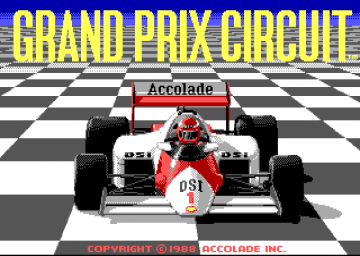Learn the basics of the game first. Play as Beginner (automatic transmission, no spinning) before proceeding to higher difficulties, and play glitchless before experimenting with major glitches like gearshift hold.
Play each track enough to memorize the layout and figure out how to approach and exit each turn. Use the diagonal keys to control the car; brake with 1 and 3 rather than 2, and turn with 7 and 9 rather than 4 or 6. Outside of a few extended slow turns where speed has to be constantly controlled, it's generally best to accelerate through the turn, so also hold down the 8 key while turning with 9 or 7. To avoid spinning out at higher difficulties, briefly take your finger off the turning key while still holding down 8.
Achieving top-end times generally requires manual transmission, so move to the third-easiest difficulty once you have mastered the basics. There are four reasons this tends to be faster than Beginner despite the increased difficulty: 1) you can push the engine to its limits and get a bit more speed out of lower gears (particularly useful on Ferrari tracks like Brazil); 2) you can always shift down when desirable, allowing faster acceleration out of many turns (such as the Curva Parabolica); 3) in race and qualifying situations, you can start much faster by revving up the engine before time starts; 4) damaged car strategies cannot be used at the easiest difficulty.
If you never get comfortable with shifting gears, there is one track where you can be competitive with automatic transmission. Ferrari and McLaren are close to parity on the flying lap at Britain (Silverstone); and the Ferrari lap can be completed without ever slowing below 170 miles per hour, making gear changes unnecessary. In this case, the easiest difficulty may even help by preventing spins.
Damaged car strategy
While all cars lose some speed on shifting gears, damaged cars lose less speed than undamaged cars do. Although damaged cars are also harder to keep under control, they are often still the better option for a flying lap; in Hockenheim, for example, McLarens damaged to the red zone outperform an undamaged McLaren by approximately half a second as long as they avoid spinning out at the Ostkurve.
The ideal level of damage depends on both the track and the car; deeper red is generally preferable on a Ferrari than on a McLaren. (This is caused by differences in the two cars' speed loss formulas, as well as the very low spin resistance of a close-to-broken McLaren.)
Getting the best starts
To get a fast start on a McLaren (with manual transmission), engage first gear when the RPM meter shows at least 10,000. To hit the good spot just beyond 10,000, get your bearings from the first beep, anticipate the second beep and floor the 8 key just before it, and hit your up-shift key when the RPM needle hits 10,000; concentrate entirely on the needle; ignore the lights and the third beep. Even if your timing was a little off and the needle is only at 8,000 or 9,000 when you hear the third beep, you should still wait for the needle to hit 10,000 before shifting up. Engaging first gear any earlier will ruin your start.
A safer strategy is to anticipate more and wait for the beep; the needle zooming past 10,000 RPM before the green light comes on is okay as long as you don't try to upshift too early. This is only marginally slower than the ideal start, and carries less risk in an All Races run.
The ideal strategy for a Ferrari is essentially the same: anticipate the second beep and engage first gear just beyond 10,000 RPM. Ferrari starts are much less precise, though; being off in either direction costs little time.

